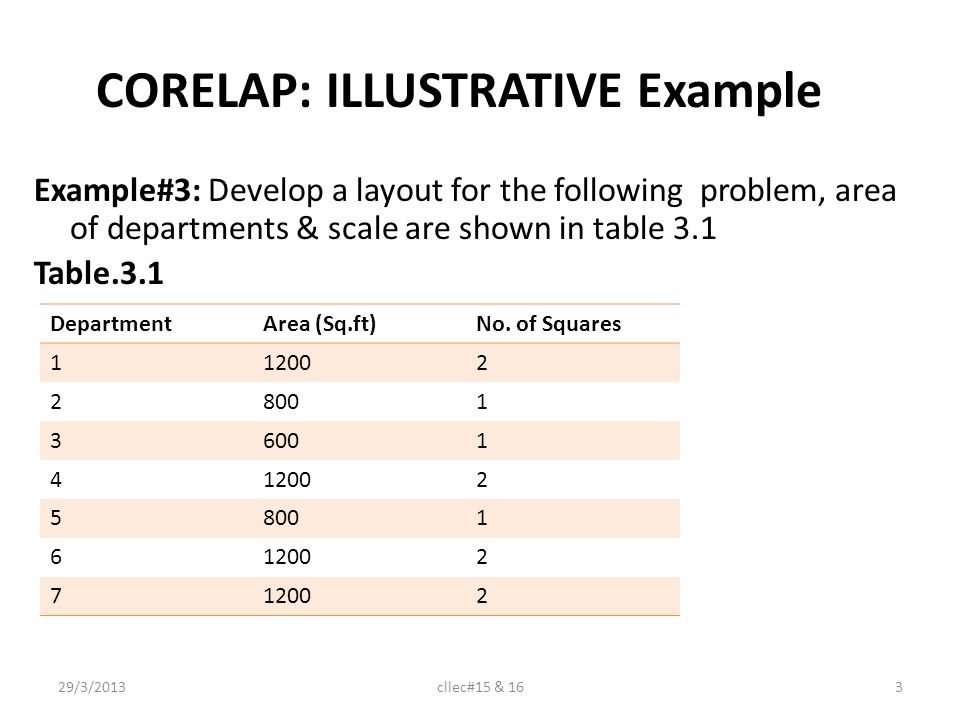
Corelap Layout Software
OPERATIONS MANAGEMENT ASSIGNMENT Topic: COMPUTERIZED LAYOUT ANALYSIS TECHNIQUES Submitted By: SAMYADIP CHAKRABORTY MOHD. ABDUL NAYEEM PhD Batch -2010 COMPUTERIZED LAYOUT ANALYSIS TECHNIQUES In the field of computerized layout analysis, a number of computerized layout programs have been developed since the 1960s and 70s. But the most time tested computerized layout techniques and software program packages that are frequently used are- CRAFT, CORELAP, ALDEP, etc.
Originally developed in late 60’s and early 70s, many of these packages are still around with latest additions to their features. Layout problems often involve a given number of facilities which must be located in the plane. Each of these facilities has a given area. This technique only utilizes graphic and schematic analysis for materials flow but does present a well-organized enumeration of pertinent qualitative factors. These factors are incorporated into a methodology for the determination of which sub-groups or departments most require adjacent placement as well as for the evaluation of several proposed layout solutions.
Aldep software Aldep software ALDEP is an acronym for automated layout design program. Random selection process, Francis and White 1974, p. PS, As a student of LEAN Six Sigma, this forum has been a.
CORELAP CORELAP is Computerized Relationship Layout Planning. This algorithm is based on Muther’s procedure given in Systematic Layout Planning. The input requirements to CORELAP are -Number of departments and their area, Closeness relationship as given by REL-chart and Weighted ratings for REL-chart entries.
Acpi pnp0510 for windows 7 drivers download. Working with Corelap: CORELAP (Computerized Relationship Layout Planning) is a simple method in facility layout and location discipline which is usually used to design a factory and facility. As a facility of living, house should be designed by using CORELAP method. Following this is an example of house design in 180m2 land (12 meters x 15 meters). There are 3 steps to design with CORELAP method such as plan the rooms, size, and room’s relationship; calculation and design the CORELAP; and draw a draft layout. First, a house consists of 15 rooms that the name of room, size, and relationship are showed in the “Activity/Space Relationship Diagram” and “Relationship Table” below.
The rating of relationship between two rooms is sign as A, E, I, O, U, or X. The definition of “A” is absolutely. 1932 Words 8 Pages I. Introduction The Monte Carlo Simulation is a computerized mathematical technique that allows people to account for risk in quantitative analysis and decision.
It furnishes the decision-maker with a range of possible outcomes and probabilities that they will occur for any chance of action. It shows the extreme possibilities of things as well. The system calculates results over and over, each time using a different set of random values from the probability functions. The simulation could involve. 1706 Words 7 Pages Job analysis:- job analysis provide a information to company at where which person are fit according his duties.
Job analysis helps to solve problem in a organisation according to ability. Then they use the most suitable alternative, which is best for employee and organization. Then they do implement those to staff and make them to follow by the each employee in their organization.
Two purpose of job analysis 1. Recruitment and selection: They try to find the people who already have some experience. 345 Words 1 Pages WEKA Analysis The machine learning techniques that were utilized in this data analysis project were both applied to the Iris Data Set available at the UCI Machine Learning Repository (This data was entered into a text file and saved with a.csv extension, then this.csv file was fed into the WEKA software for analysis. Construction planning and management by p s gahlot pdf writer.
One of the techniques utilized was a simple visualization of the data spread, which has some predictive power in clearly demonstrating. 1417 Words 6 Pages Investigation and Analysis Technique The following report examines a three types of investigation techniques – Fault Tree Analysis, Event Tree Analysis and Failure Mode and Effect Analysis. The methodology of the report is based on a research on the developmental history and procedural methodology of these three analytical techniques. This research paper will identify the strength and weaknesses of all three techniques and an opinion on which method is preferred. In the last section of the report.